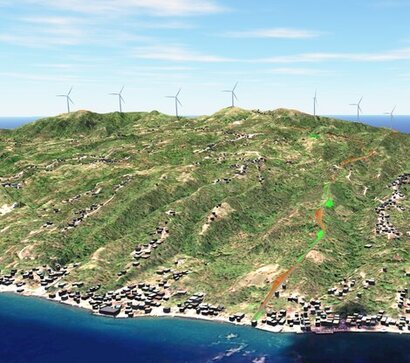
The Reihoku-Amakusa project in Japan is under construction, while the Mabini Wind Power Project in the Philippines is pre-development phase.
The development of onshore wind farms is an inherently complex process, with significant costs and time tied to specialised equipment, storage, multimodal transportation, skilled labour, and equipment downtime. Even a 1–2 percent increase in efficiency during the developing and pre-development phases can save developers millions and accelerate construction, shortening the timeline to bring a site online.
The Reihoku-Amakusa project in Japan involves the construction of 13 wind turbines with a total capacity of 54.6 MW. The project faces major logistical challenges, including severe tidal restrictions at the arrival port, requiring components to be transferred via smaller vessels or barges before reaching land. Additionally, Japan’s mountainous terrain means there is limited available land for wind turbine storage and construction staging, making just-in-time logistics, including staff and delivery of major components, critical to project success.
The Mabini Wind Power Project, currently in the planning stage, aims to generate approximately 50 MW of capacity from 6 to 8 turbines. The project highlights challenges unique to the Philippines and other emerging wind energy markets, where essential infrastructure is still being developed. One major challenge is the lack of an arrival port for secondary offshore transport, requiring the construction of a Temporary Landing Pad. This adds complexity to logistics, demanding precise scheduling and efficient resource allocation.
While both projects highlight unique challenges, Renova looks to deploy precision logistics in order to overcome obstacles found in both. By integrating Shoreline’s AI-powered simulation platform, Renova aims to optimise resource allocation and delivery of major components, improve project efficiency and reduce costs.
The platform helps analyse various data, including weather patterns and logistical constraints, to accurately schedule transportation and construction activities. This ensures that resources like specialised vessels and engineering teams are used effectively, reducing downtime and boosting operational efficiency. The platform also enables Renova to assess the impact of offshore secondary transportation, optimise vehicle placement, and streamline the construction process for onshore projects.
“Shoreline Wind's technology allows us to plan our projects more effectively by reducing operational costs and improving overall performance during the planning and construction phases” said Takaaki Kurihara, Lead Civil Engineer, Renova. “Integrating Shoreline's advanced simulation software is a crucial step in scaling our operations internationally while maintaining the highest standards of efficiency and sustainability.”
Hidemi Yanagi, Principal Engineer (Civil), Renova, added that the platform uses ERA5 data including atmospheric, land, and oceanic climate variables to improve onshore wind farm construction planning by analysing downtime and identifying areas for improvement.
“It accounts for seasonal variations and waiting times, providing a more realistic and feasible construction plan. By addressing key sources of downtime, Renova can create a more efficient schedule” said Mr Yanagi.
While Shoreline was initially designed for offshore wind, it is increasingly demonstrating the potential to be used for onshore wind simulations, further enhancing construction planning, development, and operational management in the onshore market.
“By simulating the construction phase of an onshore wind project with the most comprehensive and reliable data sources, including expected weather patterns and resource availability, Renova will reduce downtime and maximise operational efficiency” said Ole-Erik Endrerud, Founder and Chief Product Officer at Shoreline Wind. “We are excited to support Renova’s planning strategy globally.. This approach ensures that expensive resources are used more effectively, which is crucial in the challenging and often costly wind energy environment.”
For additional information:

